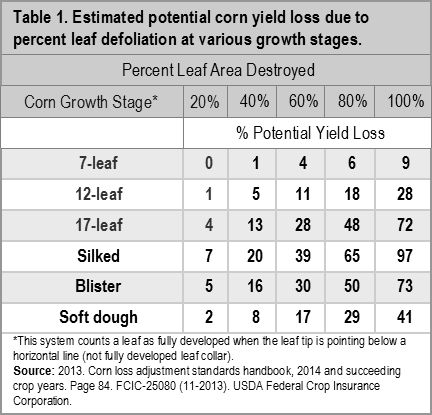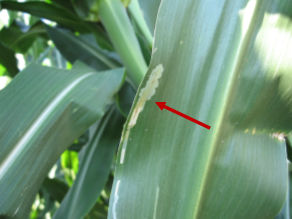3 MIN READ
Corn Blotch Leafminer
September 10, 2018
KEY POINTS
- Corn blotch leafminer (CBL) is an occasional corn pest that feeds within corn leaves.
- CBL feeding usually does not result in potential yield loss.
- Insecticide applications are not effective in controlling CBL larvae that are feeding, as they are protected within the leaf structure.
Identification and Life Cycle
Corn blotch leafminer (CBL) is considered a sporadic, minor pest. The adult is a small gray to brown fly, about 1/4 inch long, and during the growing season females insert eggs into corn leaves. After egg hatch the larva tunnel into leaves. Larvae are pale-green to yellowish-white and about 1/4 inch long when fully grown. Mature larvae chew out of the leaf and drop down to the soil to pupate. About four to six weeks are required to complete the entire CBL life cycle. There can be several generations per year, but typically the first generation does the most leaf damage.1 As corn matures, leaves thicken and larvae from later CBL generations generally tunnel in only the lower or upper half of the leaf, causing less damage.
Damage Symptoms and Thresholds
Larvae feed on internal leaf tissue, leaving transparent tunnels or mines (Figure 1 and 2 ). The tunnel from one larvae usually widens as the larvae grows, resulting in a broad blotch in the last third to half of the mine.2 Numerous mines on a single leaf can merge giving the leaf an overall bleached appearance.3 Also, in heavy infestations when the entire leaf is mined, the foliage dries up and shrivels, giving the plant a frosted appearance.4
There are no sampling methods or economic thresholds for CBL.3 Although research on the effect of CBL leaf feeding on yield potential is nearly non-existent, entomologists believe CBL damage is usually noneconomic.
Potential losses from CBL can be estimated using hail damage data.3 Using this data, a 4% yield potential loss in 7-leaf corn would require 60% defoliation (Table 1, page 2). To incur a 5% yield potential loss in 12 or 17-leaf corn, mining damage would have to be 40 and 25%, respectively.5 This is the best information currently available to estimate potential yield loss, but it is not based on CBL feeding damage. Hail damage is based on whole plant damage versus CBL feeding that occurs on leaves generally in the lower portion of the plant canopy.

Management Considerations
Foliar insecticide applications are not effective for CBL control because the egg and larvae are inside the leaves, protected from insecticides. Adult flies emerge over several weeks and would require multiple insecticide applications. In addition, broad-spectrum insecticides may kill predators and parasites which are important for suppression of CBL and other corn pests such as spider mites and aphids. Corn blotch leafminer populations are normally suppressed by numerous species of parasitic wasps.1,2,4
180828120703

